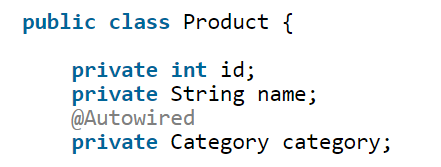首先呢
Spring是一个基于IOC和AOP结构的J2ee系统的框架
IOC 是反转控制,也是Spring的基础Inversion Of Control, 在之前呢,创建对象都是我们自己new的,然后进行各种配置,现在IOC呢就是把这一步交给Spring来做。
DI 依赖注入 Dependency Inject. 简单地说就是拿到的对象的属性,已经被注入好相关值了,直接使用即可。
比如我们准备好一个Category的bean:
package com.how2java.pojo;
public class Category {
public int getId() {
return id;
}
public void setId(int id) {
this.id = id;
}
public String getName() {
return name;
}
public void setName(String name) {
this.name = name;
}
private int id;
private String name;
}
然后在src目录下新建applicationContext.xml文件
applicationContext.xml是Spring的核心配置文件,通过关键字c即可获取Category对象,该对象获取的时候,即被注入了字符串"category 1“到name属性中
<?xml version="1.0" encoding="UTF-8"?>
<beans xmlns="http://www.springframework.org/schema/beans"
xmlns:xsi="http://www.w3.org/2001/XMLSchema-instance"
xmlns:aop="http://www.springframework.org/schema/aop"
xmlns:tx="http://www.springframework.org/schema/tx"
xmlns:context="http://www.springframework.org/schema/context"
xsi:schemaLocation="
http://www.springframework.org/schema/beans
http://www.springframework.org/schema/beans/spring-beans-3.0.xsd
http://www.springframework.org/schema/aop
http://www.springframework.org/schema/aop/spring-aop-3.0.xsd
http://www.springframework.org/schema/tx
http://www.springframework.org/schema/tx/spring-tx-3.0.xsd
http://www.springframework.org/schema/context
http://www.springframework.org/schema/context/spring-context-3.0.xsd">
<bean name="c" class="com.how2java.pojo.Category">
<property name="name" value="category 1" />
</bean>
</beans>配置好之后,就可以通过spring获取到category对象,和在xml中注入好的name属性了。
package com.how2java.test;
import org.springframework.context.ApplicationContext;
import org.springframework.context.support.ClassPathXmlApplicationContext;
import com.how2java.pojo.Category;
public class TestSpring {
public static void main(String[] args) {
ApplicationContext context = new ClassPathXmlApplicationContext(
new String[] { "applicationContext.xml" });
Category c = (Category) context.getBean("c");
System.out.println(c.getName());
}
}原理图:
站长的说法就是,传统的方式就像我们new了一只鸡,还需要自己进行很多工序之后才能吃,而ioc方式能就相当于我们去饭店,饭店把菜做好,我们直接吃。
注入对象:
创建一个Product 的bean,里面带有属性category 。
然后在xml里面通过ref来给product注入category对象。
<?xml version="1.0" encoding="UTF-8"?>
<beans xmlns="http://www.springframework.org/schema/beans"
xmlns:xsi="http://www.w3.org/2001/XMLSchema-instance" xmlns:aop="http://www.springframework.org/schema/aop"
xmlns:tx="http://www.springframework.org/schema/tx" xmlns:context="http://www.springframework.org/schema/context"
xsi:schemaLocation="
http://www.springframework.org/schema/beans
http://www.springframework.org/schema/beans/spring-beans-3.0.xsd
http://www.springframework.org/schema/aop
http://www.springframework.org/schema/aop/spring-aop-3.0.xsd
http://www.springframework.org/schema/tx
http://www.springframework.org/schema/tx/spring-tx-3.0.xsd
http://www.springframework.org/schema/context
http://www.springframework.org/schema/context/spring-context-3.0.xsd">
<bean name="c" class="com.how2java.pojo.Category">
<property name="name" value="category 1" />
</bean>
<bean name="p" class="com.how2java.pojo.Product">
<property name="name" value="product1" />
<property name="category" ref="c" />
</bean>
</beans>然后从spring那里拿到对象p之后,通过p.getCategory就可以获取到p中注入好的对象category啦
注解方式:
在上面的注入对象都是通过xml中的代码实现的,还是比较繁琐的。
还有一种方式很简单的实现注入:那就是注解哈哈哈
在applicationContext.xml中加上一句:
<context:annotation-config/>表示告诉spring,我要开始用注解的方式进行配置了。
然后注解掉刚才在product中通过ref注入category的那句。
然后在product bean中,定义category的上面加上@Autowired

然后运行测试可以发现和之前的注入对象达到了同样的效果。
除了@Autowired之外 还可以Resource(name="c")来达到同样的效果,区别在下面代码的注释上写上了。
package com.how2java.pojo;
import org.springframework.beans.factory.annotation.Autowired;
import org.springframework.stereotype.Component;
@Component("p")
public class Product {
private int id;
private String name ="product 1 1";
@Autowired //是按类型找
//@Resource(name="c")是先按提供的名称找,找不到再按类型找
private Category category;
public int getId() {
return id;
}
public void setId(int id) {
this.id = id;
}
public Category getCategory() {
return category;
}
public void setCategory(Category category) {
this.category = category;
}
public String getName() {
return name;
}
public void setName(String name) {
this.name = name;
}
}
那么上面就是通过注解来解决注入对象的问题,
出自之外,上面的product、category 这些bean的本身,也可以脱离applicationContext.xml的限制,通过注解来进行。
首先把之前xml中的beans内容全去掉。
只增加一条
<context:component-scan base-package="com.how2java.pojo"/>这是告诉spring我的bean都在com.how2java.pojo这个包目录下。
然后在之前的bean类上加上@Component
@Component("p")
public class Product {运行,也能达到同样的结果,而且代码简单了很多。
AOP
AOP 即 Aspect Oriented Program 面向切面编程
首先,在面向切面编程的思想里面,把功能分为核心业务功能,和周边功能。
所谓的核心业务,比如登陆,增加数据,删除数据都叫核心业务
所谓的周边功能,比如性能统计,日志,事务管理等等
周边功能在Spring的面向切面编程AOP思想里,即被定义为切面
在面向切面编程AOP的思想里面,核心业务功能和切面功能分别独立进行开发
然后把切面功能和核心业务功能 "编织" 在一起,这就叫AOP
准备业务类 ProductService
package com.how2java.service;
public class ProductService {
public void doSomeService(){
System.out.println("doSomeService");
}
}准备日志切面 LoggerAspect
ackage com.how2java.aspect;
import org.aspectj.lang.ProceedingJoinPoint;
public class LoggerAspect {
public Object log(ProceedingJoinPoint joinPoint) throws Throwable {
System.out.println("start log:" + joinPoint.getSignature().getName());
Object object = joinPoint.proceed();
System.out.println("end log:" + joinPoint.getSignature().getName());
return object;
}
}applicationContext.xml中加上:
<bean name="s" class="com.how2java.service.ProductService">
</bean>
<bean id="loggerAspect" class="com.how2java.aspect.LoggerAspect"/>
<aop:config>
<aop:pointcut id="loggerCutpoint"
expression=
"execution(* com.how2java.service.ProductService.*(..)) "/>
<aop:aspect id="logAspect" ref="loggerAspect">
<aop:around pointcut-ref="loggerCutpoint" method="log"/>
</aop:aspect>
</aop:config> aop:pointcut表示核心业务内容,expression中的表示在执行这个地址下的方法之后会调用切面内容。
aop:aspect 中的就是切面内容。
<?xml version="1.0" encoding="UTF-8"?>
<beans xmlns="http://www.springframework.org/schema/beans"
xmlns:xsi="http://www.w3.org/2001/XMLSchema-instance" xmlns:aop="http://www.springframework.org/schema/aop"
xmlns:tx="http://www.springframework.org/schema/tx" xmlns:context="http://www.springframework.org/schema/context"
xsi:schemaLocation="
http://www.springframework.org/schema/beans
http://www.springframework.org/schema/beans/spring-beans-3.0.xsd
http://www.springframework.org/schema/aop
http://www.springframework.org/schema/aop/spring-aop-3.0.xsd
http://www.springframework.org/schema/tx
http://www.springframework.org/schema/tx/spring-tx-3.0.xsd
http://www.springframework.org/schema/context
http://www.springframework.org/schema/context/spring-context-3.0.xsd">
<context:component-scan base-package="com.how2java.pojo"/>
<bean name="s" class="com.how2java.service.ProductService">
</bean>
<bean id="loggerAspect" class="com.how2java.aspect.LoggerAspect" />
<bean id="TimingAspect" class="com.how2java.aspect.TimingAspect" />
<aop:config>
<aop:pointcut expression="execution(* com.how2java.service.ProductService.*(..))" id="loggerCutpoint"/>
<aop:aspect id="logAspect" ref="loggerAspect">
<aop:around pointcut-ref="loggerCutpoint" method="log"/>
</aop:aspect>
<aop:aspect id="TimeAspect" ref="TimingAspect">
<aop:around pointcut-ref="loggerCutpoint" method="show_time"/>
</aop:aspect>
</aop:config>
</beans>